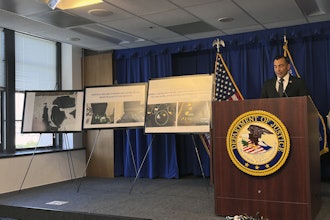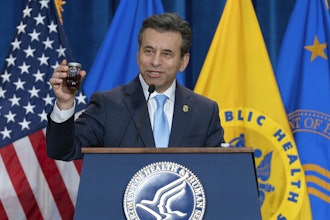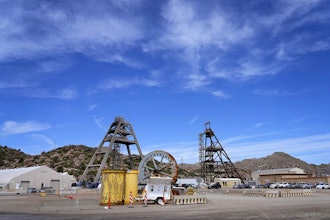
JOTOLCHEN, Mexico (AP) — The coronavirus pandemic is threatening the future of a generation of the world’s children, depriving them of schooling and sending them to work. Across the developing world, two decades of gains against child labor are eroding.
With classrooms shuttered and parents losing their jobs, children are trading their ABC’s for the D of drudgery: Reading, writing and times tables are giving way to sweat, blisters and fading hopes for a better life.
Instead of going to school, children in Kenya are grinding rocks in quarries. Tens of thousands of children in India have poured into farm fields and factories. Across Latin America, kids are making bricks, building furniture and clearing brush, once after-school jobs that are now full-time work.
These children and adolescents are earning pennies or at best a few dollars a day to help put food on the table.
“Child labor becomes a survival mechanism for many families.” says Astrid Hollander, UNICEF’s head of education in Mexico.
Governments are still analyzing how many students have dropped out of their school systems, but with school closures affecting nearly 1.5 billion children around the world, UNICEF estimates the numbers could be in the millions.
Experts say the longer their education is put on hold, the less likely children will return to school. The ramifications, especially for those already lagging, can be lifelong -- narrowed job opportunities, lower potential earnings and greater likelihood of poverty and early pregnancy.
“The repercussions could be felt in economies and societies for decades to come,” Henrietta Fore, executive director of UNICEF, the U.N. children’s agency, warned in August. For at least 463 million children whose schools closed, there is no possibility of remote learning.
It is, she said, a “global education emergency.”
___
The same week the UNICEF report was issued, a new school year started for nearly 30 million students in Mexico. In remote places where distance learning is not feasible, teachers deliver workbooks to villages and then arrange to retrieve them later.
Joel Hernández, director of a school in Jotolchén, in the mountains of central Chiapas state, said he went to pick up the workbooks recently and only about 20% of students had completed the work.
Neither 11-year-old Andrés Gomez nor his siblings had done it. Until March, when the school closed, Andrés spent his days there learning to speak, read and write Spanish -- his native language is Tzotzil. After the bell he would follow his dad into the amber mine for a couple of hours.
Now each morning he goes to work inside that a dark, hand-carved tunnel which lacks supports or safety measures. With a flashlight lashed to his head he whips a heavy hammer back and forth over his shoulder driving a steel spike into the rock. He can’t stand up. He crouches on the flakes of rock he chips away, each blow followed by a quiet grunt.
The hope is to find a piece of amber for which a middleman might pay him $1 to $5. The bit of petrified sap would likely end up sold as jewelry to tourists.
“What I want to learn is to read and write,” he says.
Andrés could take advantage of online or televised learning, but like many others he has no access to technology; there is no computer or television in his family’s two-room home, just an old stereo.
“If Dad is going to the fields, to the coffee grove, to the mine, the child is not going to stay at home with nothing to do,” Hernández says. “For them, to sit around watching television, if they have it, is like wasting time.”
There are seven children in Andrés’ family, four of school age. An 8-year-old sister helps her pregnant mother do laundry and cook food; Andrés and an older brother work in the mine with their father
Miners pay a monthly rent to the landowner to dig for amber, a payment that comes due whether they find any or not. When Andrés is not mining he helps an uncle with livestock, cutting firewood and clearing brush. In his spare time he reverts to the boy he is, shooting marbles and laughing.
He misses school: “I learned the vowels, the teacher taught, we copied and then I went to the mine,” he says. His school, a single room with posters of vocabulary and historical figures on the walls and messages still on the chalkboard, sits vacant.
Mexican law prohibits children younger than 14 from working. Children under 16 can’t do hazardous or unhealthy work. But children commonly work around school to help their families get by.
Mexican education officials recently said that enrollment for the new school year was down about 10%, but teachers warn that many students enrolled out of habit, but aren’t participating.
“Some kids will probably drop out, maybe not in elementary school, but those who finished sixth grade this year,” Hernández says. “Those probably won’t continue on to middle school.”
___
In El Alto, a suburb perched above Bolivia’s capital of La Paz, five siblings between the ages of 6 and 14 years old are bundled in hats and coats against the chilly mountain air as they and their parents work all in their family’s small carpentry workshop.
The youngest, 6-year-old Mariana Geovana, would have started kindergarten this year; instead, she smooths miniature furniture with scraps of sandpaper. Jonatan, 14, the most experienced, uses the electric saw to cut lengths of wood for doll-size beds and full-size chests of drawers.
“I’m frustrated not being able to go to school,” he says. “You learn talking with your classmates and your teachers.”
The Bolivian government decided to cancel the school year in August because it said there was no way to provide an equitable education to the country’s nearly 3 million students. In a country where informal employment makes up 70% of the economy, the closure of schools immediately put more kids to work.
“We have seen new children and adolescents selling in the street,” says Patricia Velasco, manager of a municipal program for at-risk people in the capital La Paz. “They’ve been pushed to generate income.”
Watching Mariana, Jonatan and his other children at work -- and sending the older kids out into the streets to sell their pieces -- Hector Delgado, 54, knows what is at stake. “For the students the closure of the school year is a catastrophe. They’re not going to make up the time and I strive for them to be more than carpenters.”
But Delgado, head of the local Artisans Council in El Alto, said the family had burned through their savings and now didn’t have money to buy lumber to carry on with its business.
He and his wife, María Luisa, are doing what they can to ensure their children don’t fall behind. Under their mother’s watchful eye, the children work through schoolbooks they were given in February at the start of the school year. Each morning in the workshop, she has them take time to study.
The family’s commitment to education is most apparent in an adjacent room. There, eldest son Cristian, 21, continues his management classes online through a public university.
___
The dark earth bricks produced by the rustic brickyards of the small town of Tobatí, 43 miles (70 km) from Asunción, are used to construct buildings across Paraguay. Large open kilns made from those very same mud bricks stand next to almost every home; row upon row of identical bricks dry in the open air.
With the help of his 10-year-old son, Hugo Godoy shovels mounds of clay and sandy earth, preparing to make the next day’s bricks.
As he leans on his spade, his son wanders off to sit with two infants by the house -- Godoy’s grandchildren. His son does more than help at home; since schools stopped operating in March, Godoy had also been sending him to work at a nearby larger factory.
“I spoke to the owner and said that if he gave him light work — moving the raw materials and things like that — then I’d let him go,” Godoy said, speaking in his native Guarani language. “There are lots of children working.”
Another of Godoy’s sons, who is 15, is working full time at the same factory, earning around $10 a day loading bricks onto tall trucks. Before the pandemic he worked just part time. “I don’t put the older ones to work here at home: I tell them to go and find some way to help with our situation,” Godoy said.
In Paraguay, children from 12 to 14 can carry out only “light tasks” in family enterprises, while adolescents of 15 to 17 can hold jobs that do not appear on a list of the 26 “worst forms of child labor” -- as long as it does not interfere with their schooling.
Members of brickmaking families said school closures -- scheduled to last at least until December -- have led to many children and adolescents working longer hours. And these new schedules have made it difficult to complete their virtual schoolwork.
Godoy said he had discovered that his son had missed exams, and “After that, I told him to let me know when he has exams so that he doesn’t have to go to work those days. Whatever happens, we’ll find a way to manage and make ends meet, I told him.”
Paraguay’s government set up virtual classrooms for distance learning, but families cited a number of associated costs, including cell phone data plans as well as printing and copying for their children’s class work. A UNICEF report said that 22% of students were participating in the virtual classrooms while 52% were trying to keep up with assignments via WhatsApp.
“I know lots of cases of 15-year-olds who have been doing well at school but haven’t been able to afford the costs,” said Godoy. “They stop studying and start working.”
___
At a quarry in Nairobi, Florence Mumbua works alongside her children, ages 7, 10 and 12. Mumbua lost her cleaning job at a private school when the pandemic hit, and the family doesn’t have the resources for the children to learn online. So together they crush rock, each earning about 65 cents a day.
“I have to work with them because they need to eat and yet I make little money. When we work as a team, we can make enough money for our lunch, breakfast and dinner,” Mumbua said.
Child labor is illegal in Kenya. But so is child prostitution, and it too has thrived since school closed.
Mary Mugure, a former sex worker turned activist through her Night Nurse organization, says up to 1,000 schoolgirls have become sex workers in the three Nairobi neighborhoods she monitors since schools shut in March. The youngest, she said, was 11.
In India, Dhananjay Tingal fears that millions more children will “fall back into trafficking, child labor and child marriage because the economic crisis is looming large.”
As executive director of the Bachpan Bachao Andolan -- a children’s rights group whose founder, Kailash Satyarthi, won the Nobel Peace Prize in 2014 -- Tingal has watched with horror as child labor grows in a country that already has one of the world’s worst records.
A harsh nationwide lockdown imposed in March pummeled the Indian economy and pushed millions of people into poverty, forcing many poor families to put their children to work to make ends meet. When the economy opened, tens and thousands of children took jobs in farms and factories.
“This is a serious problem,” he said.
___
Experts say in the past, most students who have missed class because of crises like the Ebola epidemic returned when schools reopened. But the longer the crisis drags on, the less likely they will go back.
Yliana Merida, a researcher at the Autonomous University of Chiapas, Mexico, said that even more than before, the pandemic has turned education into a luxury. “Many parents opt for ‘you’re going to work to help me at home because right now we really need it.’”
In Nuevo Yibeljoj, another community in the mountains of Chiapas, 12-year-old Samuel Vázquez watches closely as his father, Agustín, writes syllables on scraps of paper and sticks them to the wall. He sits in a small chair beside his brother, using the bed as a desk as his father kneels between them.
They had just returned from working in the fields, something the brothers used to do only on weekends. Since schools closed in March, they’ve worked weekdays, weeding and helping with the crops.
Samuel enjoys farm work and one day wants to grow coffee and fruit trees like his father, but he misses school. He’s a good student and helps his younger siblings. “I like addition a lot and reading,” he says.
Samuel is fortunate that his father makes time to help them study, though he himself has only an elementary school education.
“I try, but it’s not the same as a teacher, because I’m a farmer,” says Agustín, 52.
He has 12 children, four of whom are school age. He was sick with COVID-19 and recovered. What worries him is the future.
“We aren’t afraid of the coronavirus,” he says. “What worries us a lot is education, which is being lost.”






















